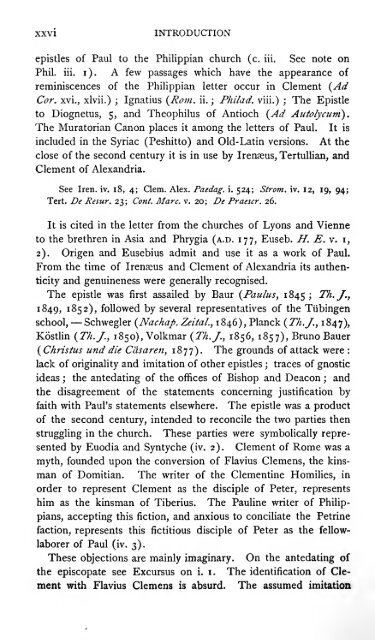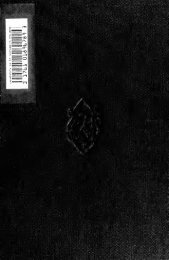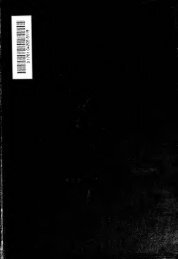Philippians and Philemon - MR Vincent - 1906.pdf
Philippians and Philemon - MR Vincent - 1906.pdf
Philippians and Philemon - MR Vincent - 1906.pdf
You also want an ePaper? Increase the reach of your titles
YUMPU automatically turns print PDFs into web optimized ePapers that Google loves.
XXVI INTRODUCTION<br />
epistles of Paul to the Philippian church (c. iii. See note on<br />
Phil. iii. i). A few passages which have the appearance of<br />
reminiscences of the Philippian letter occur in Clement {Ad<br />
Cor. xvi., xlvii.) ; Ignatius {Rom. ii. ; Philad. viii.) ; The Epistle<br />
to Diognetus, 5, <strong>and</strong> Theophilus of Antioch {Ad Autolycum).<br />
The Muratorian Canon places it among the letters of Paul. It is<br />
included in the Syriac (Peshitto) <strong>and</strong> Old- Latin versions. At the<br />
close of the second century it is in use by Irenseus, TertuUian, <strong>and</strong><br />
Clement of Alex<strong>and</strong>ria.<br />
See Iren. iv. 18, 4; Clem. Alex. Paedag. i. 524; Strom, iv. 12, 19, 94;<br />
Tert. De Resur. 23; Cont. Marc. v. 20; De Praescr. 26,<br />
It is cited in the letter from the churches of Lyons <strong>and</strong> Vienna<br />
to the brethren in Asia <strong>and</strong> Phrygia (a.d. 177, Euseb. H. E. v. i,<br />
2). Origen <strong>and</strong> Eusebius admit <strong>and</strong> use it as a work of Paul.<br />
From the time of Irenseus <strong>and</strong> Clement of Alex<strong>and</strong>ria its authen-<br />
ticity <strong>and</strong> genuineness were generally recognised.<br />
The epistle was first assailed by Baur {Paulus, 1845; Th. J.^<br />
1849, 1852), followed by several representatives of the Tubingen<br />
school, — Schwegler {Nachap. Zeital., 1846), Planck {Th.J., 1847),<br />
Kostlin {Th.J., 1850), Volkmar {Th.J., 1856, 1857), Bruno Bauer<br />
{Christus und die Cdsaren, 1877). The grounds of attack were :<br />
lack of originality <strong>and</strong> imitation of other epistles ; traces of gnostic<br />
ideas ; the antedating of the offices of Bishop <strong>and</strong> Deacon ; <strong>and</strong><br />
the disagreement of the statements concerning justification by<br />
faith with Paul's statements elsewhere. The epistle was a product<br />
of the second century, intended to reconcile the two parties then<br />
struggling in the church. These parties were symbolically repre-<br />
sented by Euodia <strong>and</strong> Syntyche (iv. 2). Clement of Rome was a<br />
myth, founded upon the conversion of Flavius Clemens, the kinsman<br />
of Domitian. The writer of the Clementine Homihes, in<br />
order to represent Clement as the disciple of Peter, represents<br />
him as the kinsman of Tiberius. The Pauline writer of Philip-<br />
pians, accepting this fiction, <strong>and</strong> anxious to conciliate the Petrine<br />
faction, represents this fictitious disciple of Peter as the fellow-<br />
laborer of Paul (iv. 3).<br />
These objections are mainly imaginary. On the antedating of<br />
the episcopate see Excursus on i. i. The identification of Cle-<br />
ment with Flavius Clemens is absurd. The assumed imitation





